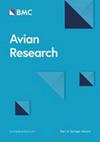Evaluation of antimicrobial resistance and virulence characteristics in Escherichia coli and Proteus mirabilis isolates from dead Crested Ibis embryos at the artificial breeding base
IF 1.7
2区 生物学
Q1 ORNITHOLOGY
引用次数: 0
Abstract
Bacterial infections of avian embryos can lead to an increase in embryo mortality, and the proliferation of antimicrobial-resistant bacteria aggravates the situation. A low hatching rate also poses a challenge to the population of artificially bred Crested Ibises (Nipponia nippon). This study aims to determine the potential association between bacterial infection and the death of Crested Ibis embryos, and whether there is convergence between antimicrobial resistance and virulence in strain. In this study, 13 Escherichia coli and 12 Proteus mirabilis isolates were recovered from dead Crested Ibis embryos. The pathogenicity examination confirmed the pathogenicity of all isolates, and multiple virulence genes detected by PCR-sequencing demonstrated the presence of irp2 and iucD (100%), fimC and iss (92.31%) in E. coli, and ucaA (58.33%) in P. mirabilis. Antimicrobial susceptibility test demonstrated that isolates were mainly resistant to amoxicillin (E. coli: 76.92%, P. mirabilis: 91.67%), cefazolin (E. coli: 76.92%, P. mirabilis: 91.67%), oxytetracycline (E. coli: 92.31%, P. mirabilis: 75.00%) and sulfamethoxazole-trimethoprim (E. coli: 53.85%, P. mirabilis: 33.33%), and more than 30% of isolates showed multidrug-resistance (MDR). Further analyses detected extended-spectrum β-lactamase (ESBL) genes, of which blaTEM-1 (E. coli: 100%, P. mirabilis: 100%) had the highest frequency, followed by the blaCTX-M-55 (E. coli: 92.31%, P. mirabilis: 50%), blaCTX-M-14 (E. coli: 76.92%, P. mirabilis: 33.33%), blaCTX-M-65 (E. coli: 15.38%, P. mirabilis: 16.67%), and all isolates were negative for blaSHV and blaOXA. Pearson's correlation analysis showed a positive correlation between the presence of β-lactam resistance and ESBL genes, while mainly negative correlations were observed between the presence of ESBL genes and virulence genes. Furthermore, the conjugation experiment and PFGE revealed that the isolates were primarily polyclonal, and there was horizontal transfer of resistance or virulence genes by plasmids. Based on the results, E. coli and P. mirabilis were responsible for embryonic mortality of the ibises in this study. The co-presence and co-transfer of ESBL genes and virulence genes can pose a potential threat to the health of the Crested Ibis, and measures such as prudent use of antimicrobials, and constant surveillance of resistance and pathogenicity, must be implemented at the Crested Ibis breeding base.
人工养殖基地朱鹮死亡胚胎中大肠埃希菌和奇异变形杆菌分离株的耐药性和毒力特性评价
禽类胚胎的细菌感染可导致胚胎死亡率增加,而抗微生物细菌的增殖使这种情况更加恶化。低孵化率也对人工繁殖朱鹮(Nipponia nippon)种群构成挑战。本研究旨在确定细菌感染与朱鹮胚胎死亡之间的潜在关联,以及菌株中抗菌素耐药性和毒力之间是否存在趋同。本研究从死亡的朱鹮胚胎中分离出13株大肠杆菌和12株奇异变形杆菌。致病性检查证实了所有分离株的致病性,pcr测序检测到的多个毒力基因显示,大肠杆菌中存在irp2和iucD (100%), fimC和iss (92.31%), P. mirabilis中存在ucaA(58.33%)。药敏试验结果显示,分离株主要耐药于阿莫西林(大肠杆菌:76.92%,奇异杆菌:91.67%)、头孢唑林(大肠杆菌:76.92%,奇异杆菌:91.67%)、土霉素(大肠杆菌:92.31%,奇异杆菌:75.00%)和磺胺甲恶唑-甲氧苄啶(大肠杆菌:53.85%,奇异杆菌:33.33%),30%以上的分离株出现多重耐药(MDR)。进一步分析检测到的广谱β-内酰胺酶(ESBL)基因中,blaTEM-1(大肠杆菌:100%,神奇p: 100%)频率最高,其次是blaCTX-M-55(大肠杆菌:92.31%,神奇p: 50%)、blaCTX-M-14(大肠杆菌:76.92%,神奇p: 33.33%)、blaCTX-M-65(大肠杆菌:15.38%,神奇p: 16.67%), blaSHV和blaOXA均为阴性。Pearson相关分析显示,β-内酰胺抗性与ESBL基因存在正相关,而ESBL基因存在与毒力基因主要呈负相关。此外,结合实验和PFGE分析表明,分离菌株主要是多克隆的,并且存在抗性或毒力基因通过质粒水平转移的现象。结果表明,大肠杆菌和奇异假单胞杆菌是导致本研究中朱鹭胚胎死亡的主要原因。ESBL基因和毒力基因的共同存在和共同转移可能对朱鹮的健康构成潜在威胁,因此必须在朱鹮繁殖基地实施谨慎使用抗菌剂、持续监测耐药性和致病性等措施。
本文章由计算机程序翻译,如有差异,请以英文原文为准。
求助全文
约1分钟内获得全文
求助全文
来源期刊

Avian Research
ORNITHOLOGY-
CiteScore
2.90
自引率
16.70%
发文量
456
审稿时长
46 days
期刊介绍:
Avian Research is an open access, peer-reviewed journal publishing high quality research and review articles on all aspects of ornithology from all over the world. It aims to report the latest and most significant progress in ornithology and to encourage exchange of ideas among international ornithologists. As an open access journal, Avian Research provides a unique opportunity to publish high quality contents that will be internationally accessible to any reader at no cost.
 求助内容:
求助内容: 应助结果提醒方式:
应助结果提醒方式:


